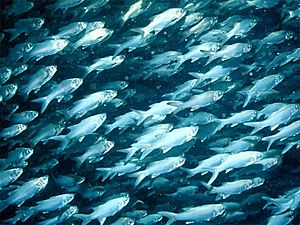Threadfin facts for kids
Quick facts for kids Threadfin |
|
|---|---|
 |
|
| Atlantic threadfin, Polydactylus octonemus | |
| Scientific classification |
|
| Kingdom: | Animalia |
| Phylum: | Chordata |
| Class: | Actinopterygii |
| Order: | Perciformes |
| Family: | Polynemidae Rafinesque, 1815 |
| Genera | |
|
See text |
|
Threadfins are a type of silvery-grey fish that belong to the family Polynemidae. You can find them in warm (tropical) and slightly warm (subtropical) waters all over the world. There are eight main groups, called genera, and about 40 different species of threadfins. Another fish, the Indian threadfish, sometimes gets called a threadfin, but it's actually from a different family.
Threadfins can be quite small, like the dwarf threadfin which is about 11 cm (4.3 in) long. But they can also be very large, like the fourfinger threadfin and giant African threadfin, which can grow up to 2 meters (6.6 ft) long! People catch threadfins for food, and they are also popular with people who like to fish. They often swim in big groups, which makes them easy to catch.
Contents
What Do Threadfins Look Like?
Threadfins have long, sleek bodies that are shaped like a torpedo. They have two dorsal fins (fins on their back) that are far apart. Their tail fins are big and deeply split, which helps them swim fast and move easily. Their mouth is large and located on the underside of their head, with a blunt snout sticking out in front. Inside their mouth, they have many tiny, brush-like teeth on their jaws and the roof of their mouth.
Their most special feature is their pectoral fins (the fins on their sides). These fins have two parts. The lower part has three to seven long, thin, thread-like rays that are separate from the rest of the fin. Some types, like Polynemus species, can have up to 15 of these special rays!
For some species, like the Royal threadfin, these thread-like rays can be super long, even reaching past their tail fin! This is why they are called "threadfins." The name Polynemidae also comes from Greek words: poly means "many" and nema means "filament" (which means thread). Other fish, like mullets and milkfish, look a bit similar. But you can easily tell them apart from threadfins because they don't have these special thread-like pectoral rays.
Where Do Threadfins Live?
Threadfins usually live in open, shallow waters where the bottom is muddy, sandy, or silty. You won't often see them near reefs. Scientists think their special pectoral rays help them feel around in the mud and sand to find food.
These fish are known for being able to live in water with different amounts of salt. This means they can swim into estuaries (where rivers meet the sea) and even up into rivers! They mostly eat small crustaceans (like shrimp and crabs) and smaller fish.
Reproduction and Life Cycle
Threadfins are thought to be "pelagic spawners." This means they probably release many tiny, floating eggs into the water. These eggs then become part of the plankton and float freely with the ocean currents until they hatch.
Threadfins as Food
Threadfin meat has been used to make things like crab stick.
Farming Threadfins
In Hawaii, a type of threadfin called the sixfinger threadfin is raised in large cages in the open ocean. This is a way to farm fish for food.
Images for kids
See also
 In Spanish: Polynemidae para niños
In Spanish: Polynemidae para niños





